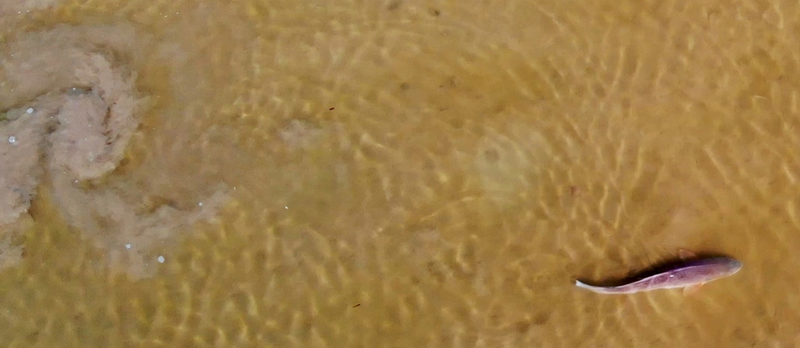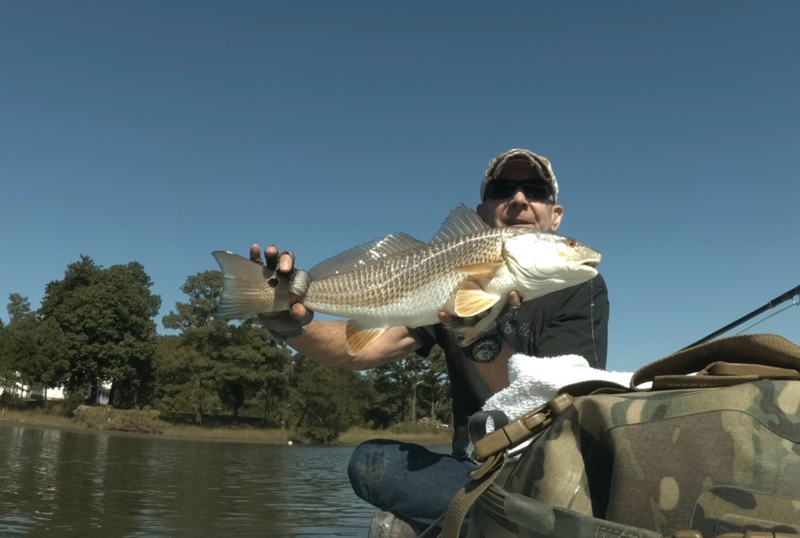When anglers think of sight fishing for red drum, they often picture scenes of tailing reds from South Carolina or Florida. But you don't need to travel to experience fantastic eyeball red fish fishing in the Chesapeake Bay region.

Red drum are found from New England down the coast around Florida and into the Gulf. They are strong fighters and can be tricked by a variety of fishing methods. They grow big, and some of the largest are taken from Virginia and North Carolina. The all-tackle world record is a 94-pound 2-ounce giant caught in North Carolina, and although we call them “bulls,” the largest redfish are usually females. Contrary to popular belief, they can be caught year-round in the lower Chesapeake Bay and I have caught them every single month of the year while sight fishing.
Early Eyeballs
Beginning in March and into May, big reds move into the shoals and inlets at the southern end of the Eastern Shore. These fish are in schools that can be spotted on sunny, light-wind days. They will move into surprisingly shallow water where they are more easily seen, but they will also swim near the surface in deeper water. You can spot them on a sonar or side scan, as well. As summer approaches, these fish spread out up the Bay and along the coast.
Don't forget the watermelon. What… what? Feeding redfish sometimes eat so much so fast that they will regurgitate under water. This creates a slick that actually smells like watermelon. When you pick up that scent, move slowly upwind and keep your eyes peeled for both a slick and/or fish.
Summer Sightings
Next comes the summer patterns. This is when anglers can see red drum on both the flats and in the flooded grasses throughout the Bay. The large schools have usually broken up into singles or small groups of a handful. At higher tides they will enter flooded marsh to feed, South Carolina style. Yes, redfish do tail in the Chesapeake Bay region, too. The water in flooded grass is usually clear enough to actually see the fish.
They can be seen again at very low tide. Bait has to move out of the marsh as the tide ebbs, and baitfish and shrimp will congregate in holes and depressions on and near flats. Redfish gather in these same places to feed. These fish can be difficult to spot in the muddy water, and you might cast to wakes and blowups as much as actually seeing the fish themselves.
In more northern areas up to and including the middle Bay, schools of bull reds can be sighted when they chase bait over open water. Although the frenzies are usually quite limited in duration many anglers “look” for the fish with their electronics, using side-scan at maximum range, when the fish aren’t driving bait to the surface and attracting tell-tale birds.
Late Season Looking
In the fall, anglers can find smaller reds as they school up again for the winter. As the water clears you can spot them more easily at mid tides and in deeper water, where they may not have been visible in summer months. Schools of larger reds move back into the lower Bay, especially near the CBBT. Once again, you can find the schools swimming along the surface.

Winter Watching
Finally, the big fish move south for the winter. However, smaller reds follow a pattern similar to speckled trout. Schools of reds, often slot-sized, will move into the backwaters of tidewater area rivers and creeks. If you find a school in a certain spot, there is a good chance they will stay close to that area all winter.
Gearing Up for Sight Fishing
Now that you know where and when, it comes to how. Kevin Whitley, commonly known as Kayak Kevin, has probably caught more big reds in the spring than anyone else — and he has caught them all from a kayak.
“I use musky rods and boat rods with the butt cut down to 11 inches,” said Whitley. He fishes “one and a half to two-ounce heavy hook jigheads with seven-inch tails. I use a Diawa Saltist with 65-pound braid coupled to an 80-pound leader.”
Fly anglers can target big reds too, with a 10-weight and a sinking line. You can still fish the sinking line in the shallows, and it can also be used on deeper reds if you notice activity on your bottom machine. You won't have to switch rods. A large Clouser minnow, in white to tan and brown colors, will work well. Always cast to the edge of a school, because you’re less likely to spook fish that way. Bait anglers can use shrimp or cut bait, clams, or crab.
Smaller offerings are needed for fish in the flooded grass. Grass fish can be spooky, and a big splash nearby might send them scurrying to deeper water. Kayak Kevin moves down to quarter- to three-quarter-ounce heads and a 40-pound leader. He likes the Live Target Fleeing Shrimp in pink. Fly anglers can use small Clouser minnows tied in pink or tan colors. Tie some with a weed-guard, and use a six- to eight-weight rod and a floating line.
Another important piece of equipment is your transportation. When the fish are super skinny, a kayak or paddleboard provides the best access. The water is often too shallow for even the highest-tech flats skiff. In slightly deeper water, a shallow draft skiff works nicely. A poling platform provides elevation for spotting fish. Poling is difficult in soft mud, but works well on flooded marsh. You can use a trolling motor if the water is deep enough, but I have seen larger summer reds spook from the shallows when a motor is activated.
If you’re fishing on foot, many flooded marshes are easily stalked on foot. However, low tide mud flats are usually too soft to wade. Find a marsh with a hard bottom, preferably with some shell in it. Reds like the mix of grass and shells. It’s important to move slowly and pause at times. If a fish is in the grass but not moving you could miss it and spook it, so stand for a while scanning the marsh and wait to see a tail or fish. Then, make your approach. I’ve had the best success when I find a fish that has found something to eat and is totally focused on the prey. You can make repeated casts to a focused fish until you get your offering close enough to be found.
Sight fishing for redfish, in Chesapeake Country? You bet it’s a thing… all you have to do is open your eyes — put on your polarized glasses and try it for yourself.
-By Kendall Osbourne